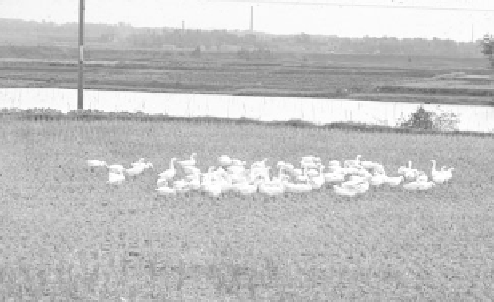Agriculture Reference
In-Depth Information
of tillage and restoration of soil health parameters, can
easily justify the reduction in emphasis on cash grain crops
(Clark 2004).
Providing Work
Fueled by the matter and energy in the plant biomass they
consume, animals are able to provide work in the form
of cultivation and transport. This was discussed above,
but it is important to note that the work performed by
animals is a form of biological cultural energy. As such,
it helps the farmer achieve more favorable ratios of energy
input to energy output and reduce purchased energy
inputs (Chapter 18). The use of draft animals may seem
anachronistic in today's world, but the rising cost of fossil-
fuel-derived energy makes it an increasingly attractive
option. A different kind of “work” is provided by honey-
bees — when kept on the farm to produce honey as a
marketable product, they also pollinate crops or fruit
trees.
FIGURE 19.10
Ducks being used to graze out weeds and
scavenge dropped seed in a rice paddy near Nanjing, China.
Waste matter is being converted into a resource in the form of
animal products and manure.
Increasing Subsequent Crop Yields in Rotations
One of the many benefits of including a grazed forage in
crop rotations is that higher yields may be obtained from
the crops planted after the forage. This effect is due to the
other positive impacts of the grazed forage period: less
soil disturbance, increased soil organic matter, and weed
control. In the Canadian farmer survey noted above, over
two-thirds of the surveyed farmers reported higher yields
in the grain crops that were planted following the forage
rotation (Entz et al., 1995).
Managing Vegetation and Controlling Weeds
Weed management appears to be a particularly important
reason why farmers include forages in their crop rotations.
In a farmer survey conducted in Canada, it was found that
more than 80% of the 235 farmers contacted, reported
reduction in weed pressure following forages (Entz et al.,
1995). Many observed good control of several of the most
problematic weeds such as wild oat (
Avena fatua
L.),
Canada thistle (
Cirsium arvensis
L.), wild mustard
(
Sinapis arvensis
L.), and green foxtail (
Setaria viridis
(L.) Beauv.).
Grazing animals can be used in other ways for land-
scape and vegetation management. Goats are used for
poison oak (
Toxicodendron diversilobum
) control in many
places of coastal California, or for weed suppression in
crop systems at the end of harvest. Sheep are known to
have been used for weed control in crops like corn before
the advent of modern herbicides in parts of the corn belt
of the U.S., and chickens are renowned for their ability to
cultivate the soil, manage pests, and control weeds in
home garden and small-scale cropping systems. Managed
appropriately, cattle, sheep, and goats can be used to graze
out undesirable species during reforestation, on young
Christmas tree farms, and on rangelands. Obviously, the
preference that most grazing livestock have for herbaceous
rather than woody vegetation would be a key factor in the
preferential removal of herb pressure in plantations of
young trees or in regenerating forests following distur-
bance. The use of grazing livestock for vegetation man-
agement has strong resemblance to the impacts of natural
grazing in places such as the Midwestern Prairies of North
America and the Serengeti Plain mentioned earlier in this
chapter (Figure 19.10).
Providing Ecosystem Services
From an ecosystem perspective, animals on the agricul-
tural landscape can provide many services beyond food
production. Many of the benefits listed above contribute
to various larger scale ecological processes:
•
Carbon sequestration
. Livestock animals are a
part of putting cover back on the land as trees
in silvopastoral systems or using perennial for-
age crops, two of the few known ways to pro-
duce a net increase in soil organic carbon,
potentially making a contribution to reducing
levels of carbon dioxide in the atmosphere.
•
Erosion control
. As integral parts of a grazed
forage rotation, animals help improve the quality
of vegetative cover, a crucial tool in soil erosion
control.
•
Maintenance of watershed health. The same fac-
tors that help in erosion control also promote
the watershed processes of infiltration, percola-
tion, and water retention discussed in Chapter 6.
•
Biodiversity protection
. The integration of ani-
mals back into the agricultural landscape —
especially small livestock and locally adapted
species and races — promotes the conservation


Search WWH ::

Custom Search